[English] 日本語
 Yorodumi
Yorodumi- PDB-6idk: Cryo-EM structure of Immature Dengue virus serotype 3 in complex ... -
+ Open data
Open data
- Basic information
Basic information
| Entry | Database: PDB / ID: 6idk | |||||||||||||||
|---|---|---|---|---|---|---|---|---|---|---|---|---|---|---|---|---|
| Title | Cryo-EM structure of Immature Dengue virus serotype 3 in complex with human antibody 1H10 Fab at pH 5.0 (Class I particle) | |||||||||||||||
 Components Components |
| |||||||||||||||
 Keywords Keywords | VIRUS / immature dengue virus / human antibody | |||||||||||||||
| Function / homology |  Function and homology information Function and homology informationsymbiont-mediated suppression of host JAK-STAT cascade via inhibition of host TYK2 activity / host cell mitochondrion / symbiont-mediated suppression of host JAK-STAT cascade via inhibition of STAT2 activity / symbiont-mediated suppression of host cytoplasmic pattern recognition receptor signaling pathway via inhibition of MAVS activity / ribonucleoside triphosphate phosphatase activity / viral capsid / double-stranded RNA binding / channel activity / monoatomic ion transmembrane transport / clathrin-dependent endocytosis of virus by host cell ...symbiont-mediated suppression of host JAK-STAT cascade via inhibition of host TYK2 activity / host cell mitochondrion / symbiont-mediated suppression of host JAK-STAT cascade via inhibition of STAT2 activity / symbiont-mediated suppression of host cytoplasmic pattern recognition receptor signaling pathway via inhibition of MAVS activity / ribonucleoside triphosphate phosphatase activity / viral capsid / double-stranded RNA binding / channel activity / monoatomic ion transmembrane transport / clathrin-dependent endocytosis of virus by host cell / methyltransferase cap1 activity / mRNA 5'-cap (guanine-N7-)-methyltransferase activity / RNA helicase activity / protein dimerization activity / host cell endoplasmic reticulum membrane / symbiont-mediated suppression of host type I interferon-mediated signaling pathway / symbiont-mediated activation of host autophagy / serine-type endopeptidase activity / viral RNA genome replication / RNA-directed RNA polymerase activity / fusion of virus membrane with host endosome membrane / viral envelope / virion attachment to host cell / host cell nucleus / virion membrane / structural molecule activity / proteolysis / extracellular region / ATP binding / metal ion binding / membrane Similarity search - Function | |||||||||||||||
| Biological species |  Dengue virus 3 Dengue virus 3 Homo sapiens (human) Homo sapiens (human) | |||||||||||||||
| Method | ELECTRON MICROSCOPY / single particle reconstruction / cryo EM / Resolution: 25 Å | |||||||||||||||
 Authors Authors | Wirawan, M. / Fibriansah, G. / Ng, T.S. / Zhang, Q. / Kostyuchenko, V.A. / Shi, J. / Lok, S.M. | |||||||||||||||
| Funding support |  Singapore, Singapore,  United States, 4items United States, 4items
| |||||||||||||||
 Citation Citation |  Journal: Structure / Year: 2019 Journal: Structure / Year: 2019Title: Mechanism of Enhanced Immature Dengue Virus Attachment to Endosomal Membrane Induced by prM Antibody. Authors: Melissa Wirawan / Guntur Fibriansah / Jan K Marzinek / Xin Xiang Lim / Thiam-Seng Ng / Adelene Y L Sim / Qian Zhang / Victor A Kostyuchenko / Jian Shi / Scott A Smith / Chandra S Verma / ...Authors: Melissa Wirawan / Guntur Fibriansah / Jan K Marzinek / Xin Xiang Lim / Thiam-Seng Ng / Adelene Y L Sim / Qian Zhang / Victor A Kostyuchenko / Jian Shi / Scott A Smith / Chandra S Verma / Ganesh Anand / James E Crowe / Peter J Bond / Shee-Mei Lok /   Abstract: Dengue virus (DENV) particles are released from cells in different maturation states. Fully immature DENV (immDENV) is generally non-infectious, but can become infectious when complexed with anti- ...Dengue virus (DENV) particles are released from cells in different maturation states. Fully immature DENV (immDENV) is generally non-infectious, but can become infectious when complexed with anti-precursor membrane (prM) protein antibodies. It is unknown how anti-prM antibody-coated particles can undergo membrane fusion since the prM caps the envelope (E) protein fusion loop. Here, we determined cryoelectron microscopy (cryo-EM) maps of the immDENV:anti-prM complex at different pH values, mimicking the extracellular (pH 8.0) or endosomal (pH 5.0) environments. At pH 5.0, there are two structural classes with fewer antibodies bound than at pH 8.0. These classes may represent different maturation states. Molecular simulations, together with the measured high-affinity pr:antibody interaction (versus the weak pr:E interaction) and also the low pH cryo-EM structures, suggest how antibody:pr complex can dislodge from the E protein at low pH. This exposes the E protein fusion loop enhancing virus interaction with endosomes. | |||||||||||||||
| History |
|
- Structure visualization
Structure visualization
| Movie |
 Movie viewer Movie viewer |
|---|---|
| Structure viewer | Molecule:  Molmil Molmil Jmol/JSmol Jmol/JSmol |
- Downloads & links
Downloads & links
- Download
Download
| PDBx/mmCIF format |  6idk.cif.gz 6idk.cif.gz | 84.4 KB | Display |  PDBx/mmCIF format PDBx/mmCIF format |
|---|---|---|---|---|
| PDB format |  pdb6idk.ent.gz pdb6idk.ent.gz | 49.1 KB | Display |  PDB format PDB format |
| PDBx/mmJSON format |  6idk.json.gz 6idk.json.gz | Tree view |  PDBx/mmJSON format PDBx/mmJSON format | |
| Others |  Other downloads Other downloads |
-Validation report
| Summary document |  6idk_validation.pdf.gz 6idk_validation.pdf.gz | 835.9 KB | Display |  wwPDB validaton report wwPDB validaton report |
|---|---|---|---|---|
| Full document |  6idk_full_validation.pdf.gz 6idk_full_validation.pdf.gz | 836.2 KB | Display | |
| Data in XML |  6idk_validation.xml.gz 6idk_validation.xml.gz | 39.7 KB | Display | |
| Data in CIF |  6idk_validation.cif.gz 6idk_validation.cif.gz | 60.3 KB | Display | |
| Arichive directory |  https://data.pdbj.org/pub/pdb/validation_reports/id/6idk https://data.pdbj.org/pub/pdb/validation_reports/id/6idk ftp://data.pdbj.org/pub/pdb/validation_reports/id/6idk ftp://data.pdbj.org/pub/pdb/validation_reports/id/6idk | HTTPS FTP |
-Related structure data
| Related structure data |  9650MC  9649C  9651C  6idiC  6idlC C: citing same article ( M: map data used to model this data |
|---|---|
| Similar structure data |
- Links
Links
- Assembly
Assembly
| Deposited unit | 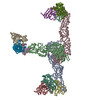
|
|---|---|
| 1 | x 60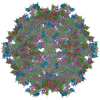
|
| 2 |
|
| 3 | x 5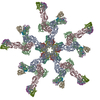
|
| 4 | x 6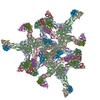
|
| 5 | 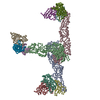
|
| Symmetry | Point symmetry: (Schoenflies symbol: I (icosahedral)) |
- Components
Components
| #1: Protein | Mass: 53682.484 Da / Num. of mol.: 3 Source method: isolated from a genetically manipulated source Details: isolated from dengue patient / Source: (gene. exp.)  Dengue virus 3 / Cell line (production host): C6/36 / Production host: Dengue virus 3 / Cell line (production host): C6/36 / Production host:  #2: Protein | Mass: 18686.615 Da / Num. of mol.: 3 Source method: isolated from a genetically manipulated source Details: isolated from dengue patient / Source: (gene. exp.)  Dengue virus 3 / Cell line (production host): C6/36 / Production host: Dengue virus 3 / Cell line (production host): C6/36 / Production host:  #3: Antibody | Mass: 15319.042 Da / Num. of mol.: 3 Source method: isolated from a genetically manipulated source Source: (gene. exp.)  Homo sapiens (human) Homo sapiens (human)Production host:  Human herpesvirus 4 strain B95-8 (Epstein-Barr virus (strain B95-8)) Human herpesvirus 4 strain B95-8 (Epstein-Barr virus (strain B95-8))#4: Antibody | Mass: 12132.362 Da / Num. of mol.: 3 Source method: isolated from a genetically manipulated source Source: (gene. exp.)  Homo sapiens (human) Homo sapiens (human)Production host:  Human herpesvirus 4 strain B95-8 (Epstein-Barr virus (strain B95-8)) Human herpesvirus 4 strain B95-8 (Epstein-Barr virus (strain B95-8)) |
|---|
-Experimental details
-Experiment
| Experiment | Method: ELECTRON MICROSCOPY |
|---|---|
| EM experiment | Aggregation state: PARTICLE / 3D reconstruction method: single particle reconstruction |
- Sample preparation
Sample preparation
| Component |
| |||||||||||||||||||||||||||||||||||
|---|---|---|---|---|---|---|---|---|---|---|---|---|---|---|---|---|---|---|---|---|---|---|---|---|---|---|---|---|---|---|---|---|---|---|---|---|
| Molecular weight | Units: MEGADALTONS / Experimental value: NO | |||||||||||||||||||||||||||||||||||
| Source (natural) |
| |||||||||||||||||||||||||||||||||||
| Source (recombinant) |
| |||||||||||||||||||||||||||||||||||
| Details of virus |
| |||||||||||||||||||||||||||||||||||
| Buffer solution | pH: 5 | |||||||||||||||||||||||||||||||||||
| Specimen | Embedding applied: NO / Shadowing applied: NO / Staining applied: NO / Vitrification applied: YES | |||||||||||||||||||||||||||||||||||
| Vitrification | Cryogen name: ETHANE |
- Electron microscopy imaging
Electron microscopy imaging
| Experimental equipment |  Model: Titan Krios / Image courtesy: FEI Company |
|---|---|
| Microscopy | Model: FEI TITAN KRIOS |
| Electron gun | Electron source:  FIELD EMISSION GUN / Accelerating voltage: 300 kV / Illumination mode: SPOT SCAN FIELD EMISSION GUN / Accelerating voltage: 300 kV / Illumination mode: SPOT SCAN |
| Electron lens | Mode: BRIGHT FIELD / Nominal magnification: 47000 X / Cs: 2.7 mm |
| Image recording | Electron dose: 18 e/Å2 / Film or detector model: FEI FALCON II (4k x 4k) |
- Processing
Processing
| EM software |
| ||||||||||||||||||||||||
|---|---|---|---|---|---|---|---|---|---|---|---|---|---|---|---|---|---|---|---|---|---|---|---|---|---|
| CTF correction | Type: PHASE FLIPPING ONLY | ||||||||||||||||||||||||
| Particle selection | Num. of particles selected: 6311 | ||||||||||||||||||||||||
| Symmetry | Point symmetry: I (icosahedral) | ||||||||||||||||||||||||
| 3D reconstruction | Resolution: 25 Å / Resolution method: FSC 0.5 CUT-OFF / Num. of particles: 2216 / Num. of class averages: 1 / Symmetry type: POINT | ||||||||||||||||||||||||
| Atomic model building | Protocol: RIGID BODY FIT Details: The initial model is the cryoEM structure of immature dengue virus in complex with Fab 1H10 at pH 8.0 |
 Movie
Movie Controller
Controller


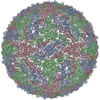
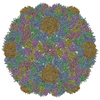
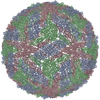
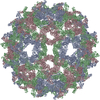

 PDBj
PDBj



